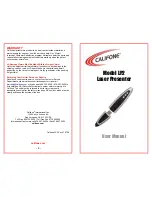
SBIG STC-428-OEM CAMERA
USER’S MANUAL
26
3.4 Understanding Calibration Groups
MaxIm LT allows you to set up the calibration frames into multiple groups of
files to provide a high level of calibration automation and flexibility, including:
•
Automatic creation of master calibration frame libraries
•
Fully-automatic calibration of images sequences involving different
exposures and binning
•
Automatic selection of flat-darks
As previously discussed, calibration requires bias, dark, and flat files. In
practice, users can often take exposures with different settings in a single
imaging session. Individual exposures may vary by exposure time, sensor
temperature, binning, subframing, and different cameras may even be in use.
Differences in binning, exposure times, and of course cameras cannot be
accommodated except by using multiple calibration frames. Switching back
and forth manually can be time consuming, particularly if complex exposure
sequences are taken with different levels of binning.
A Calibration Group is simply a set of one or more calibration frames that are
taken under the same conditions. For instance, a set of 10 dark frames taken
at -20C with a specific camera would be one group. A set of flat frames taken
at -10C with binning set to 2x2 would be another.
These groups can be automatically generated by scanning a folder or folder
tree. All image files with matching characteristics are grouped together, based
on the information in their image headers. Alternatively, the user can choose to
manually create calibration groups.
All the files in a group are combined using an average, median, sigma combine,
or SD Mask algorithm to make an internal "master frame" that is used to
calibrate images. This master frame is not visible to the user.
Some users prefer to generate and save the master calibration frames so they
can be quickly reloaded and used at a later date. The
Set Calibration
command
allows you to do this. This step is completely optional and is not required for
the calibration process to work properly.
When master calibration frames are generated and saved to disk, the list of
groups in the
Set Calibration
window is automatically replaced by these master
frame files. If bias subtraction is enabled and suitable groups are available, the
darks and flat masters will automatically be bias-subtracted. Similarly, the flat
masters will be dark-subtracted if dark subtraction is enabled and suitable
groups are available.
When the masters are saved to disk, they are tagged with image header
keywords to indicate whether these subtractions have been done. In that way
when they are loaded again later, MaxIm LT will know whether they need to
have these subtractions performed or not.
















































